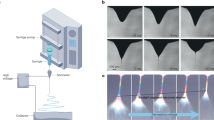Abstract
IN the examination of Recent sediments it is necessary to identify accurately the mineral grains and lithic fragments which make up the deposit. Compositional properties such as the quantity and type of quartz, feldspar, calcite and the lithic, or rock, suite are keys to the proper interpretation of source and dispersal of a sediment. Such properties as diagenetic alteration of grains, mineral inclusions and specific rock types can be determined only by optical study of specially prepared petrographic thin-sections.
This is a preview of subscription content, access via your institution
Access options
Subscribe to this journal
Receive 51 print issues and online access
$199.00 per year
only $3.90 per issue
Buy this article
- Purchase on Springer Link
- Instant access to full article PDF
Prices may be subject to local taxes which are calculated during checkout
Similar content being viewed by others
Author information
Authors and Affiliations
Rights and permissions
About this article
Cite this article
MOORE, J., GARRAWAY, S. Use of Polymethyl Methacrylate in preparing Thin Sections of Recent Sediments. Nature 200, 62–63 (1963). https://doi.org/10.1038/200062a0
Issue Date:
DOI: https://doi.org/10.1038/200062a0
Comments
By submitting a comment you agree to abide by our Terms and Community Guidelines. If you find something abusive or that does not comply with our terms or guidelines please flag it as inappropriate.



